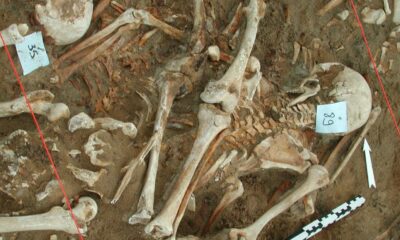Lifestyle
Scientists Uncover Ancient Diseases Impacting Napoleon’s Troops

In a groundbreaking study, scientists have analyzed ancient DNA to identify the diseases that devastated Napoleon Bonaparte’s troops during the ill-fated Russian campaign of 1812. Historical records indicate that approximately 300,000 soldiers perished, largely due to illness exacerbated by harsh conditions rather than direct military engagement. Previous accounts primarily attributed these fatalities to typhus, a louse-borne disease. However, new findings reveal that two additional diseases—paratyphoid fever and a relapsing fever—also contributed to the suffering and death of these soldiers.
The research, published in the journal Current Biology, was conducted by a team at Institut Pasteur. By examining bacterial DNA preserved in the teeth of 13 soldiers found in a mass grave, the scientists discovered fragments of Salmonella enterica, which is typically transmitted through contaminated food and water, and Borrelia recurrentis, known to be carried by lice. This analysis enhances the understanding of the dire health conditions faced by Napoleon’s army, which was already grappling with extreme cold, starvation, and exhaustion.
The campaign began in the summer of 1812 when Napoleon led an army of around half a million soldiers into Russia. The Russian military employed scorched-earth tactics, leaving the French forces in a devastated Moscow. As winter approached, the soldiers were forced to retreat, suffering immense losses not only from combat but also from disease.
Historian Stephan Talty, author of *The Illustrious Dead: The Terrifying Story of How Typhus Killed Napoleon’s Greatest Army*, noted the romanticized notion of typhus as the sole culprit behind the army’s destruction. In a recent email, he stated, “Though the sample size is small, the new evidence makes a strong case that there were other infections at work.” He emphasized that given the size of the army and the conditions they faced, it is not surprising that multiple illnesses would arise.
The mass grave, unearthed in 2001 by construction workers at a former Soviet Army barracks in Vilnius, Lithuania, contained over 3,000 remains of Napoleon’s troops. Excavations revealed how bodies had been hastily buried, with horse skeletons found alongside human remains. The positions of the skeletons suggested that the intense cold had frozen the victims in their death poses, with many buried in their boots.
The initial focus of researchers in the early 2000s was to detect the presence of Rickettsia prowazekii, the bacteria responsible for typhus. They successfully identified DNA fragments from this pathogen and also from Bartonella quintana, which causes trench fever. Recently, postdoctoral researcher Remi Barbieri proposed revisiting these samples to utilize modern gene sequencing technology for a more comprehensive analysis.
In this new study, Barbieri and Nicolas Rascovan, head of the microbial paleogenomics unit, employed genome sequencing techniques that allowed them to analyze the complete DNA fragments present in the teeth. This approach enabled them to identify not only the expected pathogens but also other microbial DNA, enriching the understanding of the health crises faced by the army.
“History buffs will be super interested,” commented Anne Stone, an anthropological geneticist at Arizona State University, on the study’s implications. The researchers found evidence of a variant of Salmonella enterica linked to paratyphoid fever, which manifests through fever, rash, and gastrointestinal distress. Additionally, they identified traces of Borrelia recurrentis, the agent of relapsing fever.
While these diseases are not typically life-threatening today, the context of Napoleon’s campaign was markedly different. “We are talking about an army that was in such a very fragile situation—pathogens like this could have been lethal,” Rascovan explained.
The study does not dismiss the presence of typhus among the soldiers but rather highlights the coexistence of multiple infections within this small sample from the mass grave. These findings contribute to a broader narrative of the hardships faced by Napoleon’s troops, which aligns with historical accounts of gastrointestinal symptoms linked to contaminated food sources. One such account is from army physician J.R.L. de Kirckhoff, who noted severe diarrhoea attributed to the consumption of salted beets.
Overall, this research underscores how advancements in microbial genetics can illuminate historical events, offering deeper insights into the factors contributing to military failures. As Talty aptly stated, “This new study reinforces how impossible the whole enterprise was; in a time before railroads and antibiotics, the invasion was doomed before it even began.”
-

 World3 weeks ago
World3 weeks agoPrivate Funeral Held for Dean Field and His Three Children
-

 Top Stories3 weeks ago
Top Stories3 weeks agoFuneral Planned for Field Siblings After Tragic House Fire
-

 Sports3 months ago
Sports3 months agoNetball New Zealand Stands Down Dame Noeline Taurua for Series
-

 Entertainment3 months ago
Entertainment3 months agoTributes Pour In for Lachlan Rofe, Reality Star, Dead at 47
-

 Entertainment2 months ago
Entertainment2 months agoNew ‘Maverick’ Chaser Joins Beat the Chasers Season Finale
-

 Sports3 months ago
Sports3 months agoSilver Ferns Legend Laura Langman Criticizes Team’s Attitude
-

 Sports1 month ago
Sports1 month agoEli Katoa Rushed to Hospital After Sideline Incident During Match
-

 Politics2 months ago
Politics2 months agoNetball NZ Calls for Respect Amid Dame Taurua’s Standoff
-

 World4 weeks ago
World4 weeks agoInvestigation Underway in Tragic Sanson House Fire Involving Family
-

 Top Stories3 weeks ago
Top Stories3 weeks agoShock and Grief Follow Tragic Family Deaths in New Zealand
-

 Entertainment7 days ago
Entertainment7 days agoJacinda Ardern Discusses Popularity Decline on Graham Norton Show
-

 Sports2 weeks ago
Sports2 weeks agoEli Katoa Shares Positive Recovery Update After Brain Surgery















